学号178原创作品,转载请注明出处,
《Linux内核分析》MOOC课程:http://mooc.study.163.com/course/USTC-1000029000
本次实验资源来自:https://github.com/mengning/linuxkernel/
一、mykernel简介
这是一个由中科大软件学院孟宁老师建立的一个用于开发属于你自己的操作系统内核的平台,基于Linux Kernel 3.9.4 source code。mykernel的源代码地址:https://github.com/mengning/mykernel
你可以根据这上面的指南将其部署到自己的系统上。此外,你也可以使用实验楼上提供的虚拟机。http://www.shiyanlou.com/courses/195。根据“实验2”的步骤即可找到并运行这个平台框架。
打开终端,通过如下指令便可打开如图所示的QEMU虚拟机了。
cd LinuxKernel/linux-3.9.4
rm -rf mykernel
patch -p1 < ../mykernel_for_linux3.9.4sc.patch
make allnoconfig
make
qemu -kernel arch/x86/boot/bzImage
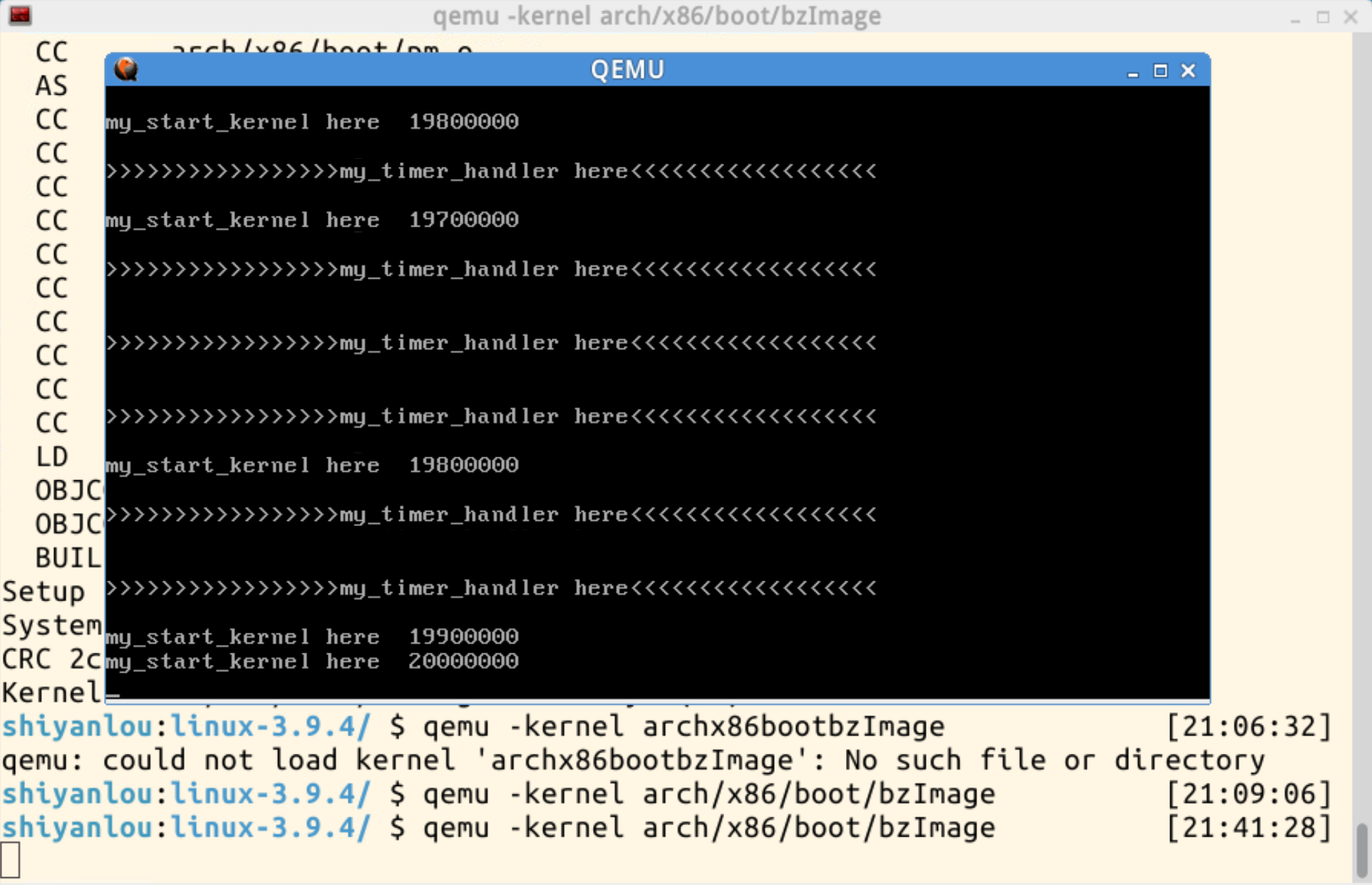
我们会发现,>>>>>>>>>>>my_timer_handler here<<<<<<<<<<<和>>>>>>>>>>>>>>>my_start_kernel here<<<<<<<<<<<<<<<<会无限循环输出。(此时一个操作系统已经在运行了,功能就是无限输出上述的两个字符串。)

如上图所示,我们依此查看myinterrupt.c和mymain.c文件
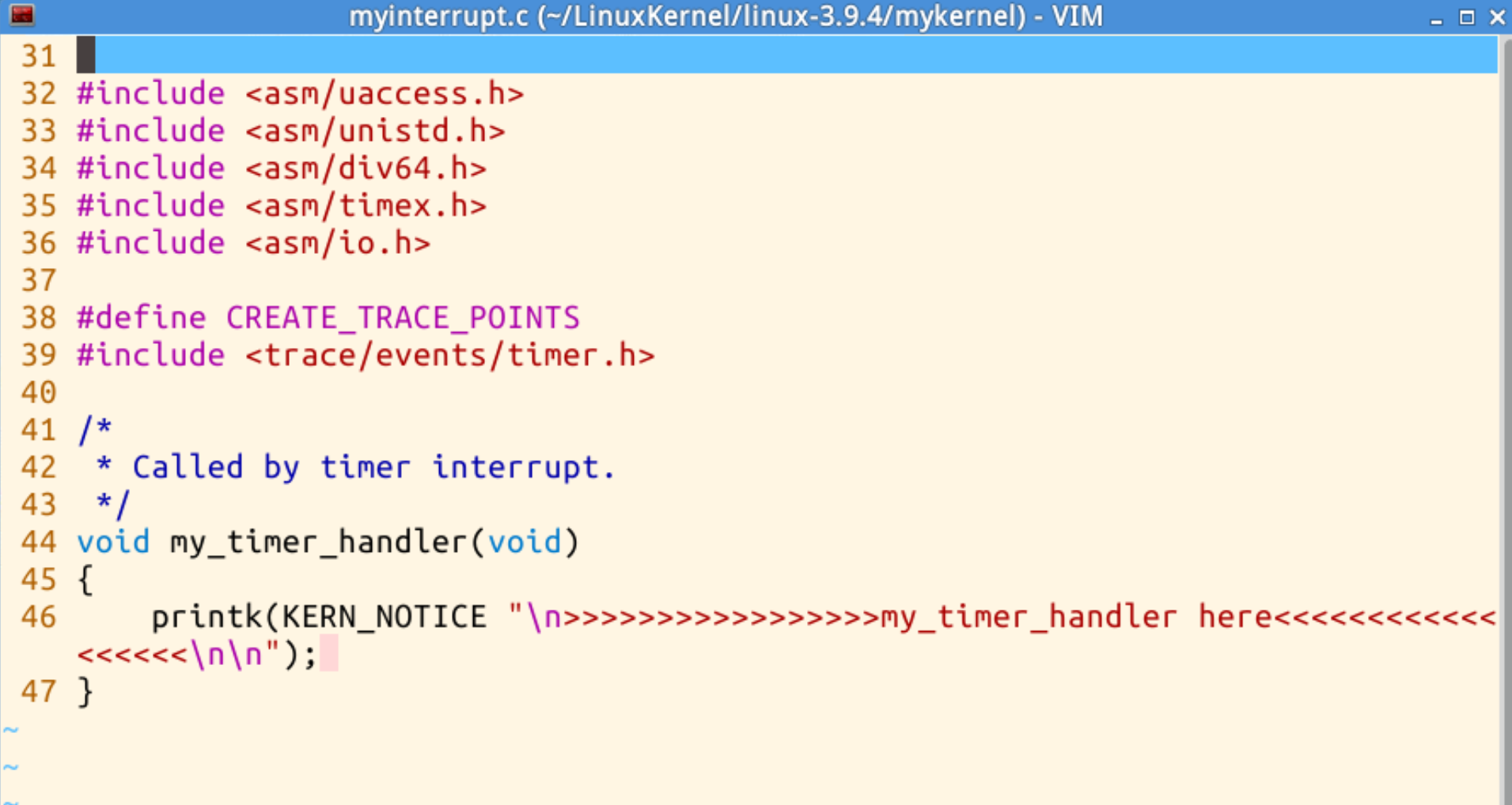
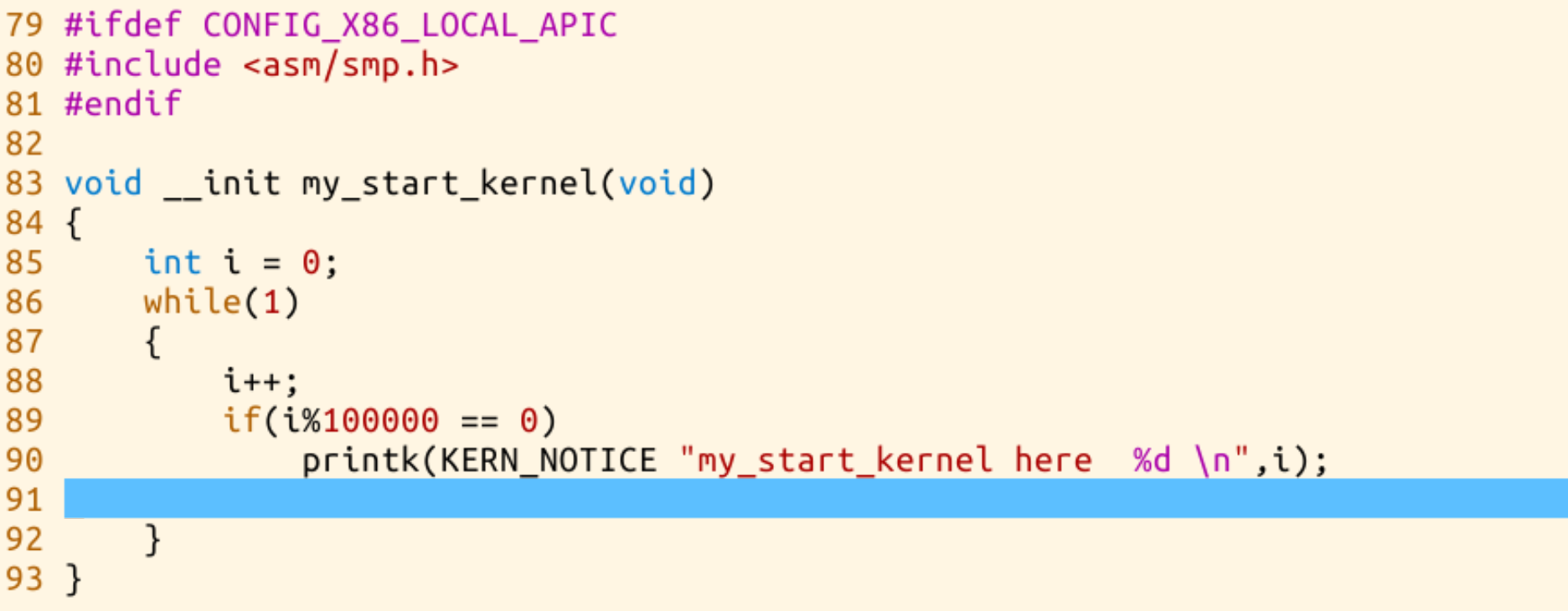
这便是实现QEMU中输出字符串功能的文件。
我们发现,mykernel系统在启动后,会一直调用这两个文件中的函数,每当i%00000为0时,周期输出my_start_kernel_here。
二、实现一个简单的时间片轮转多道程序
将孟老师GitHub上实验用的源代码https://github.com/mengning/mykernel 通过git clone指令下载到mykernel平台上。如下图所示。
之后会得到 mypcb.h、myinterrupt.c和mymain.c三个文件。

回到linux-3.9.4文件夹中,依次输入make allnoconfig、make、qemu -kernel arch/x86/boot/bzImage三条指令,得到下图:
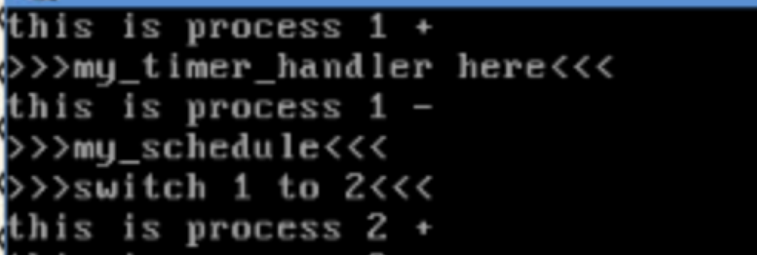
源代码分析:
1、mypcb.h:定义进程控制块PCB的结构体。
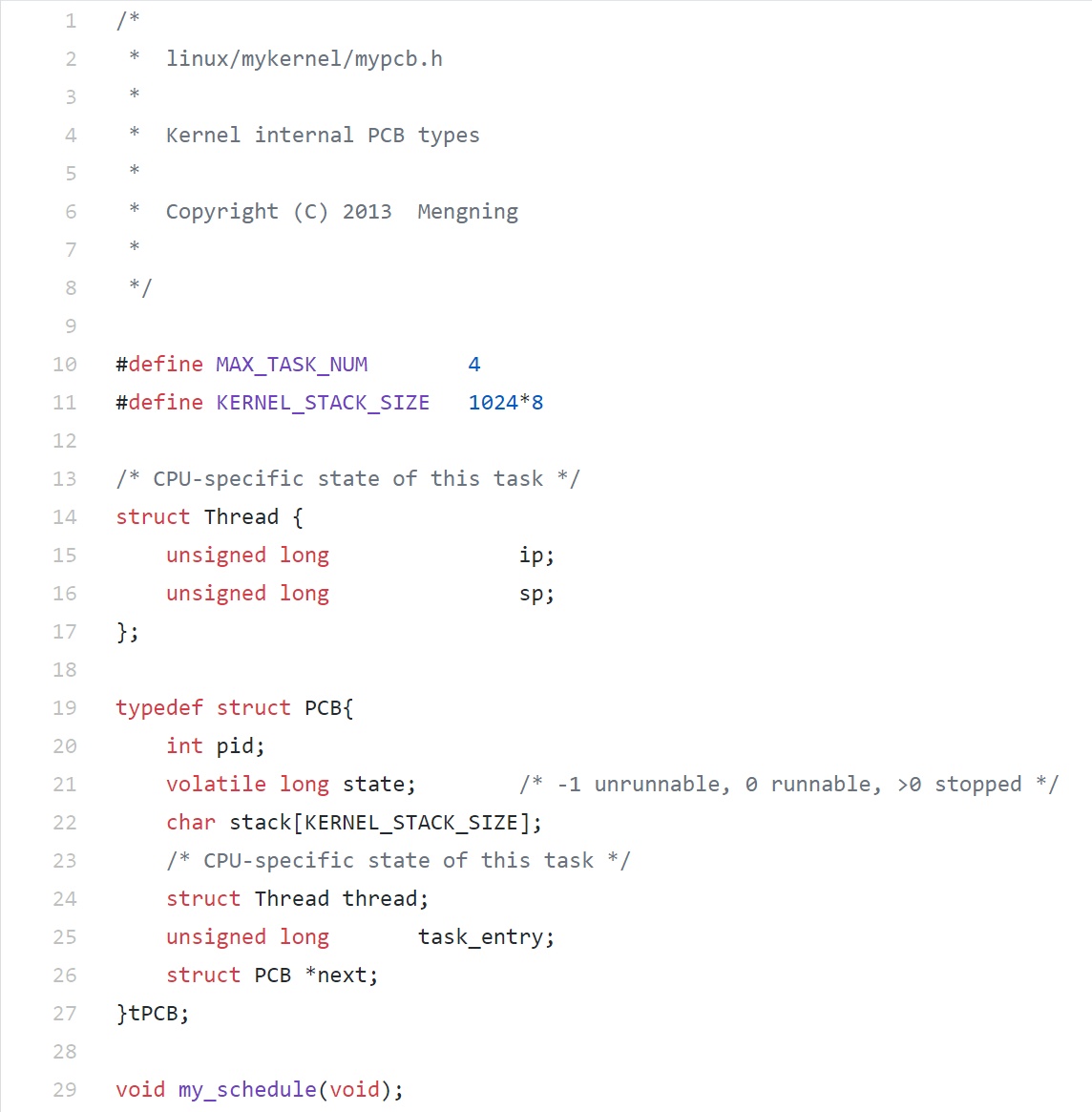
pid:进程号
state:进程状态,在模拟系统中,所有进程控制块信息都会被创建出来,其初始化值就是-1,如果被调度运行起来,其值就会变成0
stack:进程使用的堆栈
thread:当前正在执行的线程信息
task_entry:进程入口函数
next:指向下一个PCB,模拟系统中所有的PCB是以链表的形式组织起来的。
这里还有一个函数的声明 my_schedule,它的实现在my_interrupt.c中,在mymain.c中的各个进程函数会根据一个全局变量的状态来决定是否调用它,从而实现主动调度。
2、myinterrupt.c:负责时钟中断处理和进程调度。
| /* | |
| * linux/mykernel/myinterrupt.c | |
| * | |
| * Kernel internal my_timer_handler | |
| * | |
| * Copyright (C) 2013 Mengning | |
| * | |
| */ | |
| #include <linux/types.h> | |
| #include <linux/string.h> | |
| #include <linux/ctype.h> | |
| #include <linux/tty.h> | |
| #include <linux/vmalloc.h> | |
| #include "mypcb.h" | |
| extern tPCB task[MAX_TASK_NUM]; | |
| extern tPCB * my_current_task; | |
| extern volatile int my_need_sched; | |
| volatile int time_count = 0; | |
| /* | |
| * Called by timer interrupt. | |
| * it runs in the name of current running process, | |
| * so it use kernel stack of current running process | |
| */ | |
| void my_timer_handler(void) | |
| { | |
| #if 1 | |
| if(time_count%1000 == 0 && my_need_sched != 1) | |
| { | |
| printk(KERN_NOTICE ">>>my_timer_handler here<<<\n"); | |
| my_need_sched = 1; | |
| } | |
| time_count ++ ; | |
| #endif | |
| return; | |
| } | |
| void my_schedule(void) | |
| { | |
| tPCB * next; | |
| tPCB * prev; | |
| if(my_current_task == NULL | |
| || my_current_task->next == NULL) | |
| { | |
| return; | |
| } | |
| printk(KERN_NOTICE ">>>my_schedule<<<\n"); | |
| /* schedule */ | |
| next = my_current_task->next; | |
| prev = my_current_task; | |
| if(next->state == 0)/* -1 unrunnable, 0 runnable, >0 stopped */ | |
| { | |
| my_current_task = next; | |
| printk(KERN_NOTICE ">>>switch %d to %d<<<\n",prev->pid,next->pid); | |
| /* switch to next process */ | |
| asm volatile( | |
| "pushl %%ebp\n\t" /* save ebp */ | |
| "movl %%esp,%0\n\t" /* save esp */ | |
| "movl %2,%%esp\n\t" /* restore esp */ | |
| "movl $1f,%1\n\t" /* save eip */ | |
| "pushl %3\n\t" | |
| "ret\n\t" /* restore eip */ | |
| "1:\t" /* next process start here */ | |
| "popl %%ebp\n\t" | |
| : "=m" (prev->thread.sp),"=m" (prev->thread.ip) | |
| : "m" (next->thread.sp),"m" (next->thread.ip) | |
| ); | |
| } | |
| else | |
| { | |
| next->state = 0; | |
| my_current_task = next; | |
| printk(KERN_NOTICE ">>>switch %d to %d<<<\n",prev->pid,next->pid); | |
| /* switch to new process */ | |
| asm volatile( | |
| "pushl %%ebp\n\t" /* save ebp */ | |
| "movl %%esp,%0\n\t" /* save esp */ | |
| "movl %2,%%esp\n\t" /* restore esp */ | |
| "movl %2,%%ebp\n\t" /* restore ebp */ | |
| "movl $1f,%1\n\t" /* save eip */ | |
| "pushl %3\n\t" | |
| "ret\n\t" /* restore eip */ | |
| : "=m" (prev->thread.sp),"=m" (prev->thread.ip) | |
| : "m" (next->thread.sp),"m" (next->thread.ip) | |
| ); | |
| } | |
| return; | |
| } |
这里 my_timer_handler 函数会被内核周期性的调用,每调用1000次,就去将全局变量my_need_sched的值修改为1,通知正在执行的进程执行调度程序my_schedule。在my_schedule函数中,完成进程的切换。进程的切换分两种情况,一种情况是下一个进程没有被调度过,另外一种情况是下一个进程被调度过,可以通过下一个进程的state知道其状态。进程切换依然是通过内联汇编代码实现,无非是保存旧进程的eip和堆栈,将新进程的eip和堆栈的值存入对应的寄存器中,详见代码中的注释。
3、mymain.c:初始化各进程,并启动0号进程。
| /* | |
| * linux/mykernel/mymain.c | |
| * | |
| * Kernel internal my_start_kernel | |
| * | |
| * Copyright (C) 2013 Mengning | |
| * | |
| */ | |
| #include <linux/types.h> | |
| #include <linux/string.h> | |
| #include <linux/ctype.h> | |
| #include <linux/tty.h> | |
| #include <linux/vmalloc.h> | |
| #include "mypcb.h" | |
| tPCB task[MAX_TASK_NUM]; | |
| tPCB * my_current_task = NULL; | |
| volatile int my_need_sched = 0; | |
| void my_process(void); | |
| void __init my_start_kernel(void) | |
| { | |
| int pid = 0; | |
| int i; | |
| /* Initialize process 0*/ | |
| task[pid].pid = pid; | |
| task[pid].state = 0;/* -1 unrunnable, 0 runnable, >0 stopped */ | |
| task[pid].task_entry = task[pid].thread.ip = (unsigned long)my_process; | |
| task[pid].thread.sp = (unsigned long)&task[pid].stack[KERNEL_STACK_SIZE-1]; | |
| task[pid].next = &task[pid]; | |
| /*fork more process */ | |
| for(i=1;i<MAX_TASK_NUM;i++) | |
| { | |
| memcpy(&task[i],&task[0],sizeof(tPCB)); | |
| task[i].pid = i; | |
| task[i].state = -1; | |
| task[i].thread.sp = (unsigned long)&task[i].stack[KERNEL_STACK_SIZE-1]; | |
| task[i].next = task[i-1].next; | |
| task[i-1].next = &task[i]; | |
| } | |
| /* start process 0 by task[0] */ | |
| pid = 0; | |
| my_current_task = &task[pid]; | |
| asm volatile( | |
| "movl %1,%%esp\n\t" /* set task[pid].thread.sp to esp */ | |
| "pushl %1\n\t" /* push ebp */ | |
| "pushl %0\n\t" /* push task[pid].thread.ip */ | |
| "ret\n\t" /* pop task[pid].thread.ip to eip */ | |
| "popl %%ebp\n\t" | |
| : | |
| : "c" (task[pid].thread.ip),"d" (task[pid].thread.sp) /* input c or d mean %ecx/%edx*/ | |
| ); | |
| } | |
| void my_process(void) | |
| { | |
| int i = 0; | |
| while(1) | |
| { | |
| i++; | |
| if(i%10000000 == 0) | |
| { | |
| printk(KERN_NOTICE "this is process %d -\n",my_current_task->pid); | |
| if(my_need_sched == 1) | |
| { | |
| my_need_sched = 0; | |
| my_schedule(); | |
| } | |
| printk(KERN_NOTICE "this is process %d +\n",my_current_task->pid); | |
| } | |
| } | |
| } |
正如前文所述,这里的函数 my_start_kernel 是系统启动后,最先调用的函数,在这个函数里完成了0号进程的初始化和启动,并创建了其它的进程PCB,以方便后面的调度。在模拟系统里,每个进程的函数代码都是一样的,即 my_process 函数,my_process 在执行的时候,会打印出当前进程的 id,从而使得我们能够看到当前哪个进程正在执行。
另外,在 my_process 也会检查一个全局标志变量 my_need_sched,一旦发现其值为 1 ,就调用 my_schedule 完成进程的调度。
0号线程的启动,采用了内联汇编代码完成,详细参见源码中的注释。
再来看看最后一个文件,myinterrupt.c
三、总结
操作系统内核有一个起始位置,从这个起始位置开始执行。在执行了一些初始化操作,比如进程的状态设置,各个进程的栈的空间的分配后,将CPU分配给第一个进程,开始执行第一个进程,然后通过一定的调度算法度,比如时间片轮转,在一个时间片后,发生中断,第一个进程被阻塞,在完成保存现场后将CPU分配给下一个进程,执行下一个进程。这样,操作系统就完成了基本的进程调度的功能。



